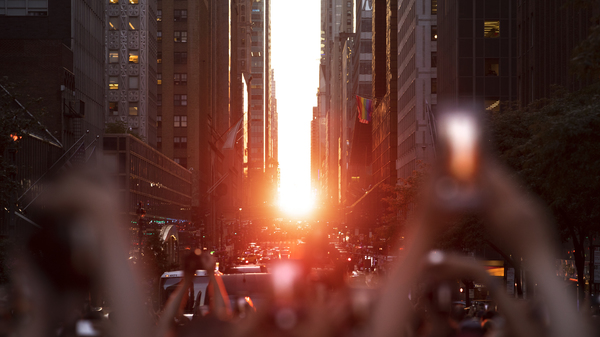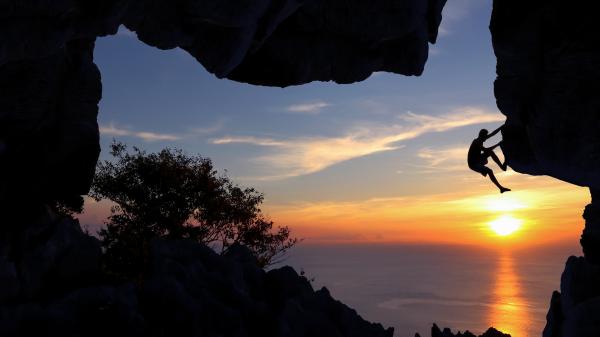Sunset and Sunrise Photography
The trick to taking beautiful photos of sunrises and sunsets is to know when and where you can find your light. It's surprisingly easy—even with a phone camera.

By knowing your light and playing around, you can take some great photos in the Sun.
©iStockphoto.com/vsurkov
It is the light and location, not the equipment, which makes a good sunrise or sunset picture. And with today's phones, you don't even need an advanced camera to capture a beautiful sky.
Plan Your Light and Location
Whether you have a phone or a more advanced camera, planning is the key to a successful shot.
- Find the Sun and its exact location in the sky.
- The golden hour, when the Sun is close to the horizon, makes the light magical.
- The blue hour is a darker stage of twilight where blue light dominates.
- Check the weather. Clouds that catch the sunlight can add a beautiful touch to the sky. Early morning mist and fog can add interest to landscapes.
- Scout your location. Lakes, the ocean, windows, and buildings reflect light and add extra oomph to your picture.
- Give yourself plenty of time. Meet up at least half an hour before you plan to start shooting.
Catch Sun Events on Camera
There are days in the year when the sunlight creates extra magical events. These are days worth planning for.

Manhattanhenge is when the Sun lines up with the street grid of Manhattan, New York, USA.
©iStockphoto.com/zxvisual
Manhattanhenge
Manhattanhenge is when sunset or sunrise aligns with the street grid lines of Manhattan, New York.
The most known Manhattanhenge happens at sunset in May and July, but a reverse Manhattanhenge also happens at sunrise in November/December and January. On specific dates, the alignment is perfect, giving that one day where the Sun’s disk perfectly aligns with the skyscrapers on both sides of the street. The day before, or after, only half of the Sun is visible over the horizon.
Although not perfectly aligned with the streets, the Sun will peak through the buildings on other days around the time of Manhattanhenge.
It was astrophysicist Neil deGrasse Tyson that first coined the term Manhattanhenge with a nod to Stonehenge in the UK. Stonehenge is a prehistoric monument that marks the change of seasons by catching the summer and winter solstice light through its ancient stones.

A partial solar eclipse at sunrise over Rice Lake, Ontario, Canada.
©iStockphoto.com/John Fader
Eclipsed Sun Rising
An eclipsed Sun rising or setting is an incredible sight to behold. Solar eclipses present a rare opportunity to capture breathtaking images of the Sun.
Solar eclipses worldwide: next 10 years
Play to Your Phone's Strengths
Phone cameras usually have a wide lens and a small sensor. Taking a picture directly at the Sun will make it look quite small in your images. But, there are several ways you can play to the strengths of your phone by catching the light just right.
- Find interesting scenery. Compose your image by including trees, buildings, or reflections.
- Move the lens. Let the Sun hit the edge of the lens to create lens flare.
- Turn off the flash. The flash will disturb the natural light.
- Turn around. Sometimes the best picture is behind you.
- Not happy with the result? Play around and try again.

Set your exposure for the sky and use silhouetted details to add drama to your shot.
©iStockphoto.com/NeagoneFo
Composing Your Image
- Test it out. Spend time at the location and take test shots to decide the composition of your photo.
- Rule of thirds. Placing your subject off-center, either a third or two-thirds into the image, can help it be more dynamic.
- Straighten your camera. Crooked horizons wreck a good shot.
- Add a foreground. Trees, people, or buildings silhouetted against the colorful sky can add depth to your photo, a common trick used by professional photographers.

Using a DSLR gives more control over exposure and post-production like cropping and editing.
©iStockphoto.com/Chalabala
DSLR Cameras
A good digital single-lens reflex camera (DSLR) can give more control over the image components.
- Use the big lens. A focal length equivalent of 200 mm or more helps the Sun look large in the image.
- Stabilize. Put your camera on a tripod or another stable surface like a fence or the ground. Use your timer, a shutter with a cord, or a remote control to minimize camera movement.
- Keep adjusting the aperture. As the Sun rises, it gets brighter, and you need a smaller aperture. As the Sun goes down, it gets darker, and a wider aperture is required.
- Manual exposure. Expose for the Sun and sky, and set the focus on your subject. Underexposure will result in richer colors.
- Flash highlights. Use a flash to light up your subject, set the exposure for the Sun and sky.
- High resolution. To capture as much information and detail as possible, set your camera to the highest resolution (jpeg) or take uncompressed images (tiff or raw).
- Keep shooting. Play around with different exposures and focus on various subjects. The light changes continuously.
- Edit your images. You can also crop, add contrast, tweak colors, layer, and so much more by processing your images using photo processing software.